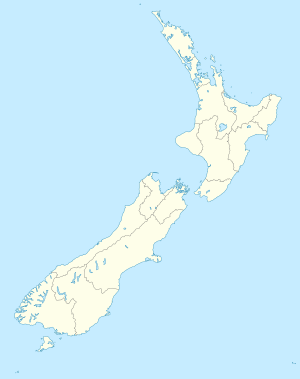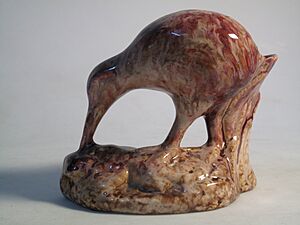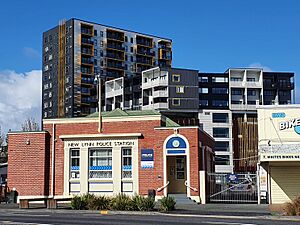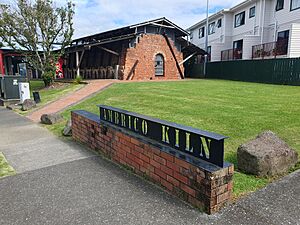New Lynn facts for kids
Quick facts for kids
New Lynn
|
|
|---|---|
|
Suburb
|
|
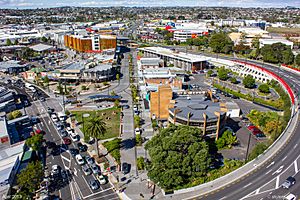
Aerial view of New Lynn town centre in 2013
|
|
| Country | New Zealand |
| Local authority | Auckland |
| Electoral ward | Whau ward |
| Local board | Whau Local Board |
| Area | |
| • Land | 636 ha (1,572 acre) |
| Population
(June 2023)
|
|
| • Total | 22,340 |
| Railway station(s) | New Lynn railway station Fruitvale Road railway station |
|
|
||
New Lynn is a busy suburb in West Auckland, New Zealand. It's about 10 kilometers southwest of Auckland's city center. This area is special because it sits along the Whau River. This river was once a very important pathway for Māori canoes (waka) between two big harbors.
New Lynn grew a lot in the early 1900s, thanks to its brick and pottery factories. In 1963, it became a major shopping spot when LynnMall opened. This was New Zealand's first American-style shopping center! Since 2010, New Lynn has been changing a lot. New homes and buildings are being built near the town center and train station.
Contents
New Lynn's Past: A Journey Through Time
Early Days and First Settlers

The New Lynn area and the Whau River belong to the Te Kawerau ā Maki iwi. This iwi is a Māori tribe whose ancestors were some of the first people in the Auckland Region. The traditional name for this area is Te Rewarewa.
The Whau River was a border between different Māori lands. It was one of the narrowest points between the Waitematā Harbour on the east coast and the Manukau Harbour on the west. This made it perfect for Te Tōanga Waka. This was a very important place where canoes could be carried between the two harbors.
When Europeans first arrived, New Lynn was mostly scrubland. In 1845, the first wooden bridge was built over the Whau River. Frederick Utting named the area New Lynn in 1863. He named it after King's Lynn in England, as it reminded him of his home. Land was first sold here in 1865, but the area grew slowly at first.
The first European settlers came in the 1850s. They were mostly farmers or worked with kauri trees and gum. In 1865, New Lynn became a trade center when its port opened on the Whau River.
The Rise of Brick and Pottery
New Lynn grew a lot because of its brick and ceramics industries. The first brickyard opened in 1852. By 1870, there were 13 brick and clay yards along the local waterways. They used the high-quality clay found in the area. Many of these companies struggled later due to tough economic times.
In March 1880, the New Lynn railway station opened. This connected New Lynn to Auckland by train and helped the area grow. The first school, New Lynn School, opened in 1888. It moved to its current location in 1914.
Growing into a Suburb
In the early 1900s, people wanted New Lynn to become its own town. They felt it was growing differently from the rural areas around it. The population grew five times between 1900 and 1910. In 1911, New Lynn became a town district. By 1919, it was big enough to become a borough. This allowed the local council to borrow money for better roads and other services. Many street names in New Lynn are named after early leaders or native trees.
The Astley Tannery, which processed leather, became a big employer during World War I. Demand for leather goods went up a lot. This business was very successful in the 1930s.
In 1925, the Rice Owen Clark factory moved its clay pipeworks to New Lynn. In 1929, many brick and ceramics businesses joined together to form the Amalgamated Brick and Pipe Company. They focused their work in New Lynn. Their factory was known for its tall, 46-meter chimney.
The Delta Theatre opened in New Lynn in 1926. It was a community hub, showing movies and hosting live shows. A new bridge over the Whau River was finished in 1931. By 1935, New Lynn's population had grown to 3,500 people.
Crown Lynn and LynnMall: A New Era
During World War II, the Amalgamated Brick and Pottery company started making crockery for New Zealand. This was because it was hard to import goods from Britain. They became one of the largest brick and ceramics companies in the Southern Hemisphere. They were famous for their Crown Lynn pottery. Many Pasifika New Zealanders moved to the area in the 1960s and 1970s. Many of them worked in the Crown Lynn factories.
The port of New Lynn stopped commercial operations in 1948.
In 1963, LynnMall opened in New Lynn. It was the first modern American-style shopping center in New Zealand. It quickly became a major shopping destination for Auckland. In September 1974, New Zealand's first Pizza Hut restaurant opened in New Lynn.
In 1989, the Amalgamated Brick and Pipe Company (then called Ceramco) closed down. In the same year, New Lynn joined other local governments to become part of Waitakere City.
Modern Development and Growth
In 2010, the New Lynn railway station was upgraded. The train tracks were moved underground. This was part of a big plan to make New Lynn a modern commercial and living area. The Merchant Quarter Apartments, one of the tallest buildings in West Auckland, opened in 2015. Today, New Lynn is a major commercial center in West Auckland.
Te Toi Uku: Crown Lynn Clayworks Museum opened in May 2015. It tells the story of New Lynn's brick and ceramics industry.
New Lynn's People
New Lynn covers about 6.36 square kilometers. As of 2023, its estimated population is 20,877 people. This means there are about 3,283 people per square kilometer.
The population has grown steadily over the years. In 2023, there were 20,877 people living in New Lynn. This was an increase of 663 people since 2018. The median age in New Lynn is 35.6 years. About 18.9% of the people are under 15 years old.
New Lynn is a diverse place. People can identify with more than one ethnicity. Many people have European, Māori, Pasifika, or Asian backgrounds. English is spoken by most people. Many other languages are also spoken, reflecting the diverse community.
Cool Places and Features in New Lynn
- Ken Maunder Park: A sports ground where you can find the Lynn-Avon United A.F.C. football club and the Suburbs New Lynn Cricket Club.
- Lawson Park: Another sports ground, home to the New Lynn Stags rugby league club.
- LynnMall: The first American-style shopping center in New Zealand, opened in 1963.
- Manawa Wetland: An artificial wetland built where an old clay quarry used to be.
- New Lynn Community Centre: Opened in 2001, it has cool artworks inside.
- New Lynn War Memorial Library and Memorial Square: The library opened in 1957. The square has sculptures inspired by waka (Māori canoes).
- Olympic Park: This park was established in 1918. It's home to the Bay Olympic football club and Waitakere Gymnastics. It was redeveloped in 2007 and has a sculpture trail.
- Ratanadipa Buddhist Temple: A Burmese Buddhist temple.
- Rewarewa Creek Footbridge: A bridge over Rewarewa Creek, designed by Virginia King in 1997.
- Te Toi Uku – Crown Lynn & Clayworks Museum: A museum that tells the story of New Lynn's brick and ceramics industry. It opened in 2015.
Getting Around New Lynn
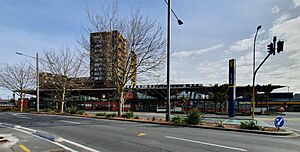
The New Lynn Railway Station is a key transport hub. It's next to the bus center and LynnMall. The station was upgraded between 2008 and 2010. The train tracks were moved into an underground trench. This allows trains to pass beneath the New Lynn town center.
New Lynn has good road access to the Auckland CBD (city center). This is thanks to the Northwestern Motorway.
The New Lynn to Avondale shared path opened in 2022. This is a special path for bikes and walkers. It connects to Auckland's wider cycle path network.
Schools in New Lynn
New Lynn has several primary schools for younger students:
- Arahoe School
- Fruitvale Road School
- New Lynn School
Oaklynn Special School is a school for students with intellectual impairments. It also has satellite classes in other nearby schools.
New Lynn does not have its own secondary schools. However, students can attend large high schools in nearby suburbs. These include Kelston Boys' High School, Kelston Girls' College, Avondale College, and Green Bay High School.


